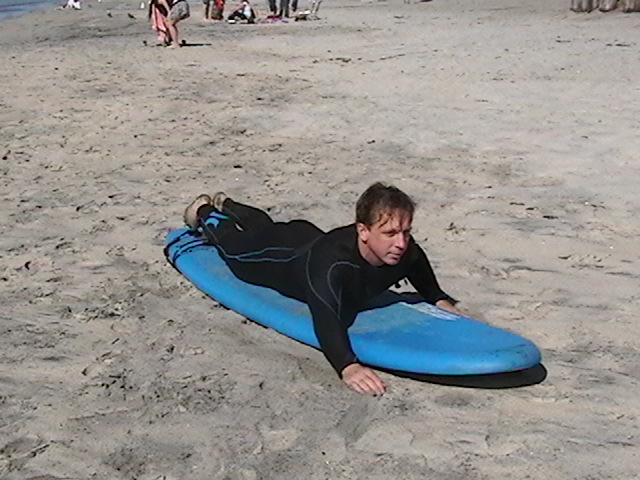The surfing pop up is executed at the time the board is in front of the wave and the board is stable. This requires technique and patience.
The surfing pop up is one technique in a series of moves from catching a wave to riding the wave. What most beginners miss is the timing.
Timing the Surfing Pop Up
When I teach beginner surfers, we start with a dry land instruction. On the beach, everything seems pretty simple and few have a problem learning the pop up technique.

Surfing pop up training
Entering the water creates a new dynamic as students have to learn paddle the board as it gyrates in the wave, discern when the surf board is stable and in front of the wave, and then move to a smooth stance. Students have an image in their head of what they have to accomplish, but it may not be in the timing required by the circumstances.
I give students a four count to repeat out loud in the water and times their body movement. Count one is paddling until the board is out in front of the wave. This often causes the biggest problem. If you watch beginners without instructors, they often jump up before the wave arrives. I have to get most students to have patience and paddle until the board is in front of the wave.
At the beginning, I push the students into the wave so I have them going straight and its easy to get in front. Once students get on the board themselves without me pushing, they have to aim the board straight to the beach, paddle until they are in front of the wave and the board is level, and then move into a smooth pop up.
The Rhythm of Surfing
When surfers can quiet their mind and get into the rhythm, the whole process is easier. There are three steps to be accomplished. The surfer has to time the wave and be moving before it arrives. Then when the wave is close and as it begins to push the board (real or foam) the surfer paddles hard for a few strokes. Once the board is moving on wave power, the surfer pops up smoothly into a stance that is balanced on the board.
When the surfer has the right stance riding a foam wave, the board will go straight and few movements are needed. If the board carves wildly to the right or left or the surfer falls off over one of the rails, it indicates the surfer’s weight is incorrect. One of the ways to slow down and get into the right stance is to pause for a second after catching the wave.
I give my students four counts and number two is placing the hands on the surf board in a man’s push up position and waiting for a second. In this second, the surfer assesses if the board is moving straight and level, and then readies his body to make a stand up move. This second prevents the surfer from launching himself onto the board while still paddling in the foam of the wave or before the board is stable.
*
For Surf Lessons in Oceanside, see the Home Page
See my Dry land and Beginner Wave Catching Video
See a good YouTube video on Catching Waves